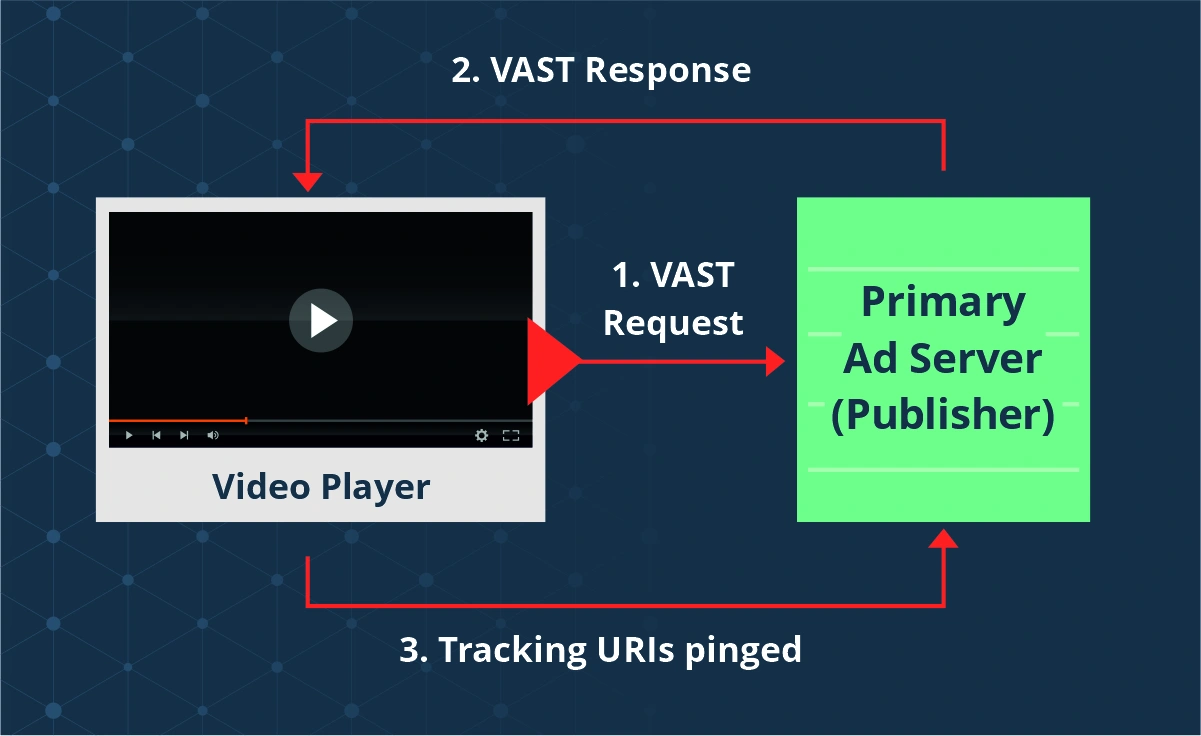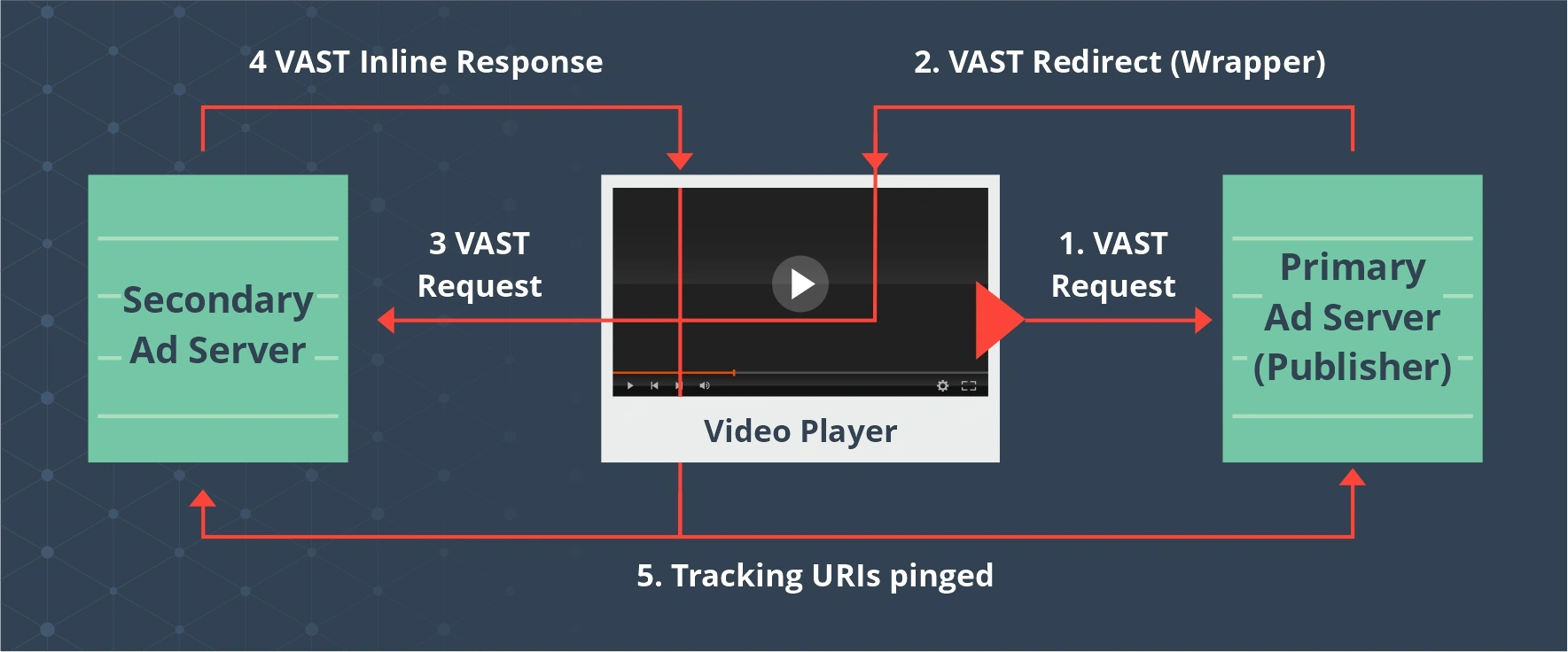Table of Contents

The video boom has been evident in the not so distant past. Users are turning their eyeballs towards video content at a rate much higher than text and audio. With increased internet accessibility and the growth of video-based platforms, this interest is not stopping anytime soon. Since users prefer video content over text and audio, it becomes obvious for advertisers and publishers to invest in them. This is where VAST comes in.
Video Ad Serving Template or VAST is a template for structuring ad tags. Publishers are adopting VAST at a great rate, and now, they have access to excellent tools to ensure maximum revenue growth with video ads.
This article will cover all there is to know about VAST for publishers, including the history, benefits, creation, validation, and critical implementation policies to take care of.
What is VAST?
Video Ad Serving Template (VAST) is a standard template structuring ad tags that serve ads to video players. Developed by the Interactive Advertising Bureau (IAB), VAST uses eXtensible Markup Language (XML) schema. VAST tags serve both audio and video ads to media players and transfer critical information about the ad from the server to the player.
The standard was created in response to the increase in video advertising and allows efficient communication between servers and video players for a good user experience. VAST instructs the video player when and how to retrieve an ad from the server, render it, and inform it about other vital details about the video, including the pricing. Besides information on the video, one can also add tracking pixels to VAST for efficient tracking.
How does VAST work?
Ads can be served on either the client-side or the server-side. For the client-side VAST, the client’s media player requests the ads from the ads server. On the other hand, for the server-side VAST, the server generates ads and stitches them into the media directly.
The whole client-side VAST process can be broken down into three steps:

- The Request: At first, the video player sends a request to the ad server to fetch the video ad.
- Inline Response: Once the ad server receives the request, it shares an inline response that contains the video media file and the necessary tracking URLs.
- Playing The Video: The player receives the creative from the Content Delivery Network (CDN) and plays it
- Pinged URLs: Once the ad is played, the video then initiates the pixel and URL tracking for metric collection by either party.
It varies slightly if a second ad server is involved in the flow:

Choosing a reliable third-party ad server will make the process smoother for the publisher. Moreover, if the ad server provides you with the right tools and reports, it can help you maximize your revenue.
A brief history of VAST
To cater to the increasing demand for video content, the first version of VAST— VAST 1.0, was created in 2008 by the Interactive Advertising Bureau (IAB). Over the years, as the demand increased and the technology behind video players improved, VAST saw multiple upgrades as well. it currently sits at VAST 4.0, which was launched in June 2018 (Source: IAB).
The first version of VAST supported MP4, 3GP, and MOV and offered basic tracking capabilities. While VAST 2.0 added quartile event and player tracking, along with some other formats, VAST 3.0 improved error reporting while allowing advertisers to display skippable ads. The latest version, VAST 4.0, introduced new capabilities for server-side support, support of raw mezzanine files, added compatibility with several different files, a new category system for ads, standardized timestamp macros, and much more.
What is a VAST tag?
A VAST tag is a third-party ad script written in XML and generated by an ad server to display video ads. The small piece of code executes the whole process and contains essential information about the ad, including the length, video format, and destination URLs. Each VAST tag contains varying parameters that change as per the publisher’s and advertiser’s requirements.
Here’s a VAST tag example with parameters such as unviewed_position_start (indicates delayed impressions for video), ciu_szs (list of companion sizes), and gdfp_req (indicates that the user is on the Ad Manager schema) assigned values.
How to create a VAST tag?
While creating a VAST tag is easy, there are multiple ways to create them.
Manually: While manually creating VAST tags does not require extensive coding knowledge, some background in XML is needed. Here are some predefined parameters required to create a VAST tag manually. Once the values for these parameters are defined, one can use them to create an XML file for the tag.
Google Ad Manager: Google is one of the most popular ad servers to create VAST tags. Google makes the process extremely easy and supports both HTTP and HTTPS URLs. Using a dedicated Google Ad Manager account, publishers can create a tag in only a few steps:
- Click on inventory
- Click Ad Units
- Locate the Ad Unit and click on tags
- Fill out the necessary details
- Copy the tag
Even though Google is the favorable ad server for creating VAST tags, advertisers can use any VAST compatible ad server. However, one should ensure that the player supports all specifications to prevent any mistakes.
Benefits of VAST
Since it was launched 14 years ago, VAST has empowered publishers and advertisers alike to leverage the increased push for video content from users.
Some benefits include:
- Providing a high revenue-generating mechanism for publishers
- Unifying the communication process between ad servers and video players
- Providing a standardized approach for both publishers and advertisers, saving time and money
- Reducing playback errors for displayed video ads
How to validate Vast tags
As all VAST tags are XML-based, it is good to validate them before they are launched to ensure there are no bugs. Publishers have the option to choose from various VAST tag validators. Here are some of the most common validators available:
- Video Suite Inspector: One of the easiest and most efficient ways to check if your VAST tag will work adequately with the IMA SDK for HTML5 is to use the Video Suite Inspector by Google. Publishers can test their VAST tags utilizing the tool with just one click!
- IAB’s VAST Tag Validator: Another reliable VAST tag validator on the market is IAB’s VAST Tag Validator. The validator supports VAST 2.0, 3.0, and 4.0 and lets publishers test required nodes and attributes in specific scenarios.
- YouTube Vast Validator: If you are serving video ads on YouTube, you can use the YouTube VAST Validator to verify that your VAST ad tags meet specifications for third-party video ads.
Conclusion
Video content has shown exponential growth, and it is not stopping anytime soon. In fact, it is expected that in 2022, online videos will make up more than 82% of all consumer internet traffic — 15 times higher than it was in 2017 (Source: Forbes). As video triumphs, it becomes critical for publishers to grab the opportunity to reach a large audience through video advertising. Using VAST tags efficiently can prove wonders for your revenue stream.
At AdSparc, we help catalyze your revenue growth with our next-generation publisher monetization solutions. If you want to try a simple and unrestrictive video solution – go for AdSparc’s ContextVid Instream Solution! It automates and effectively scales content creation for publishers.
Need a fast-loading solution that blends in with your page? Go ahead and leverage AdSparc’s lightning-fast player. In case your syndicated content rarely matches contextually with your article, and O&O (Owned & Operated) content production is expensive, transform your articles’ content into an animated video with ContextVid. If outstream is underperforming, compared to instream, you can immediately switch from outstream to instream for increased RPMs with AdSparc’s ContextVid Instream Solution! Want to know more? Request a free callback today!
Also Read: What Is Header Bidding And Open Bidding: Understanding Benefits For Publishers & How They Work







